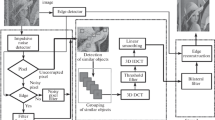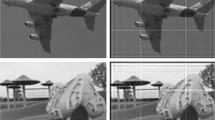Abstract
The main concept of this research is the well-accepted and recognized equation that models the pulse-transfer function (PTF) as the ratio between the Z-transform of the filter output and the Z-transform of the filter input. The proof of concept has been tested to verify the main modelling aspect using theoretical images. The proof of concept is then mathematically extended, so as to use the PTF to filter images in Z-space using Bessel, Butterworth, and type I Chebyshev filters. Z-space filtering is determined using inverse Z-transform of the pointwise multiplication between Z-space of PTF and Z-space of departing image. The filtered image is reconstructed using inverse Z-transform of the Z-space multiplication. Further, the PTF is calculated using scaled data and is called normalized transfer function (NTF). The NTF is then compared to Fourier convolution image. This paper documents methodology and technology used for the calculation of the PTF of discrete digital filters. The proof of concept is verified successfully. The novelty of this research is Z-space filtering in two dimensions using PTF.










Similar content being viewed by others
Data availability
The data sets generated during and/or analysed during the current study are available from the corresponding author on reasonable request.
Code availability
Software is freely available to the public upon request.
References
K. Abdijalilov, H. Grebel, Z-transform theory and FDTD stability. IEEE Trans. Antennas Propag. 52, 2950–2954 (2004)
Alkandari, A.M., Madouh, J.Y., Alkandari, B.A., Alfouzan, B., Soliman, S.A.: Electric Loads Modeling in the Presence of Harmonics Based on Z-Transform. In: Proceedings of the 8th International Conference on Engineering and Technology, Dubai, UAE (2014)
https://en.wikipedia.org/wiki/Bessel_filter. Accessed 26 August 2021
Bianchi, G., Sorrentino, R.: Electronic filter simulation & design. McGraw–Hill Professional, Boston, pp. 31–43 (2007)
Biolková, V., Biolek, D.: Generalized pascal matrix of first order s-z transforms. In: Proceedings of ICECS'99, 6th IEEE International Conference on Electronics, Circuits and Systems, 2, pp. 929–931 (1999)
M.J. Blachuta, On zeros of pulse transfer functions. IEEE Trans. Autom. Control. 44, 1229–1234 (1999)
F. Brophy, A. Salazar, Recursive digital filter synthesis in the time domain. IEEE Trans. Acoust. Speech Signal Process. 22, 45–55 (1974)
S. Butterworth, On the theory of filter amplifiers. Wireless Engineer 7, 536–541 (1930)
https://en.wikipedia.org/wiki/Butterworth_filter. Accessed 26 August 2021
https://en.wikipedia.org/wiki/Chebyshev_filter. Accessed 26 August 2021
F. Chen, H. Garnier, M. Gilson, J.C. Agüero, B.I. Godoy, Identification of continuous-time transfer function models from non-uniformly sampled data in presence of colored noise. IFAC Proceedings Volumes. 47, 10379–10384 (2014)
C. Ciulla, Inverse Fourier transformation of combined first order derivative and intensity-curvature functional of magnetic resonance angiography of the human brain. Comput. Methods Programs Biomed. 211, 106384 (2021)
R.W. Daniels, Approximation Methods for Electronic Filter Design: With Applications to Passive (Active and Digital Networks. McGraw-Hill, New York, 1974)
V. Demir, A.Z. Elsherbeni, E. Arvas, FDTD formulation for dispersive chiral media using the Z transform method. IEEE Trans. Antennas Propag. 53, 3374–3384 (2005)
M. Eguchi, K. Wada, Over-determined estimation of pulse transfer function model by least-squares method. IFAC Proceedings Volumes. 24, 823–828 (1991)
M. Eguchi, K. Wada, K. Nakano, Identification of pulse transfer function in the presence of input and output noise. IFAC Proceedings Volumes. 25, 463–470 (1992)
N. Feng, Y. Zhang, G.P. Wang, Q. Zeng, W.T. Joines, Compact Matrix-Exponential-Based FDTD with Second-Order PML and Direct Z-Transform for Modeling Complex Subsurface Sensing and Imaging Problems. Remote Sens. 13, 94 (2021)
Z. Gao, B. Tabachnik, R.V. Savescu, Transfer function matrix identification from input—output frequency response data. J. Franklin Inst. 331, 435–448 (1994)
R. Gessing, Word length of pulse transfer function for small sampling periods. IEEE Trans. Autom. Control. 44, 1760–1764 (1999)
Haraguchi, S., Kanae, S., Yang, Z.J., Wada, K.: Recursive TLS algorithm for estimation of Pulse Transfer Functions. In: Proceedings of the ISCIE International Symposium on Stochastic Systems Theory and its Applications, pp. 20–25 (2008)
https://en.wikipedia.org/wiki/High-pass_filter. Accessed 26 August 2021
E.I. Jury, P. Bauer, On the stability of two-dimensional continuous systems. IEEE Trans. Circuits Syst. 35, 1487–1500 (1988)
Kobayashi, H.I.S.A.T.O.: A new numerical algorithm of transformation from a transfer function matrix into a pulse transfer function matrix. IEEE Trans. Autom. Control. 27, 190–192 (1982)
M. Levin, Estimation of a system pulse transfer function in the presence of noise. IEEE Trans. Autom. Control. 9, 229–235 (1964)
K.S. Lii, M. Rosenblatt, Deconvolution and estimation of transfer function phase and coefficients for nongaussian linear processes. Ann. Statist. 10, 1195–1208 (1982)
P.H. Lin, D.S.H. Wong, S.S. Jang, S.S. Shieh, J.Z. Chu, Controller design and reduction of bullwhip for a model supply chain system using z-transform analysis. J. Process Control. 14, 487–499 (2004)
https://en.wikipedia.org/wiki/Low-pass_filter. Accessed 26 August 2021
Lu, W.S., Antoniou, A.: Design of digital filters and filter banks by optimization: A state of the art review. In: 10th European Signal Processing Conference, pp. 1–4. IEEE (2000)
Lutovac, M.D., Tošić, D.V., Evans, B.L.: Filter design for signal processing using MATLAB and Mathematica. Prentice Hall, (2000)
Mahery, H.M., Torabzad, S., Sabahi, M., Babaei, E.: Modeling and stability analysis of buck-boost DC-DC converter based on Z-transform. In IEEE 5th India International Conference on Power Electronics (IICPE) pp. 1–6. (2012)
V. Nayyeri, M. Soleimani, J.R. Mohassel, M. Dehmollaian, FDTD modeling of dispersive bianisotropic media using Z-transform method. IEEE Trans. Antennas Propag. 59, 2268–2279 (2011)
O'Brien, R.T., Iglesias, P.A.: On the poles and zeros of linear, time-varying systems. IEEE Trans. Circuits Syst. I: Fundamental Theory and Applications. 48, 565–577 (2001)
B. Psenicka, F. Garcia-Ugalde, A. Herrera-Camacho, The bilinear Z transform by Pascal matrix and its application in the design of digital filters. IEEE Signal Process Lett. 9, 368–370 (2002)
L. Rabiner, R.W. Schafer, C. Rader, The chirp z-transform algorithm. IEEE Trans. Audio Electroacoust. 17, 86–92 (1969)
J.R. Ragazzini, L.A. Zadeh, The analysis of sampled-data systems. Trans. Am. Inst. Electr. Eng. Part 2(71), 225–234 (1952)
Sinha, N.K.: Estimation of transfer function of continuous system from sampled data. In: Proc. Inst. Electr. Eng. IET Digital Library, 119, 612–614 (1972)
T. Soderstrom, Comments on “Order assumption and singularity of information matrix for pulse transfer function models.” IEEE Trans. Autom. Control. 20, 445–447 (1975)
Tanskanen, J.M.A.: Polynomial-predictive FIR design-a review. In: 2001 Finnish Signal Processing Symposium, Espoo, Finland, pp. 13–16. (2001)
https://en.wikipedia.org/wiki/Transfer_function. Accessed 26 August 2021
S. Tretter, Pulse-transfer-function identification using discrete orthonormal sequences. IEEE Trans. Audio Electroacoust. 18, 184–187 (1970)
R. Tuschak, Relations between transfer and pulse transfer functions of continuous processes. IFAC Proceedings Volumes. 14, 429–434 (1981)
S. Valiviita, S.J. Ovaska, O. Vainio, Polynomial predictive filtering in control instrumentation: a review. IEEE Trans. Ind. Electron. 46, 876–888 (1999)
K. Wada, M. Eguchi, S. Sagara, TLS method for pulse transfer function estimation in the presence of input and output noise. IFAC Proceedings Volumes. 27, 909–913 (1994)
Yao, C.Y., Shang, H.R., Scaminaci, A., Di Monte, N.: Application of Z-transform to noise response modeling of a bunch-by-bunch feedback system. Proc. IPAC’13, Shanghai, pp. 3058–3060 (2013)
Acknowledgements
The author expresses sincere gratitude for the MR images provided by Dr. Dimitar Veljanovski and Dr. Filip A. Risteski. The author is also very grateful to Professor Ustijana Rechkoska Shikoska because of the coordination of the human resources. Dr. Dimitar Veljanovski and Dr. Filip A. Risteski are affiliated with the Department of Radiology at the General Hospital 8-mi Septemvri located in Boulevard 8th September in the city of Skopje—Republic of North Macedonia. Professor Ustijana Rechkoska Shikoska is the Vice Rector of University of Information Science and Technology (UIST) located in Partizanska BB in the city of Ohrid—Republic of North Macedonia. This paper is dedicated to my beloved family.
Funding
No funding was received to support this research.
Author information
Authors and Affiliations
Corresponding author
Ethics declarations
Conflict of interest
None.
Ethical approval
MRI acquisition was consented. Approval was obtained from subjects to use the images for research through the administration of written consent. The research protocol for MRI data acquisition was approved by the Department of Radiology at the General Hospital 8-mi Septemvri located in Boulevard 8th September in the city of Skopje—Republic of North Macedonia. This study was conducted according to principles stated in Helsinki declaration of the year 1964.
Additional information
Publisher's Note
Springer Nature remains neutral with regard to jurisdictional claims in published maps and institutional affiliations.
Rights and permissions
Springer Nature or its licensor holds exclusive rights to this article under a publishing agreement with the author(s) or other rightsholder(s); author self-archiving of the accepted manuscript version of this article is solely governed by the terms of such publishing agreement and applicable law.
About this article
Cite this article
Ciulla, C. Two-Dimensional Z-space Filtering Using Pulse-Transfer Function. Circuits Syst Signal Process 42, 255–276 (2023). https://doi.org/10.1007/s00034-022-02113-4
Received:
Revised:
Accepted:
Published:
Issue Date:
DOI: https://doi.org/10.1007/s00034-022-02113-4




